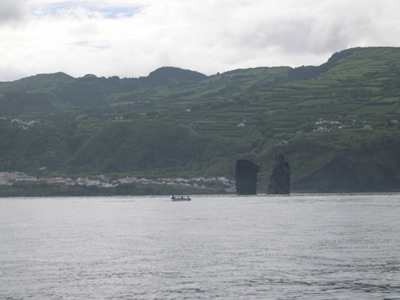Wind directions didn’t favour our
anticipated 60M trip to Santa
Maria, the other island of the eastern group of the Azores. However, we found a probably better by visiting a
fair-weather anchorage at Capelas on the north coast of São
Miguel. This took us past some impressive rock scenery near
Mosteiros on the west end of the island.


As we turned into the broad bay
that is the main feature of the north coast, we picked up an improbable-looking
slot in the cliff (just to the right of the prominent headland in the
photo).

We crept close to the cliff
along the east wall to avoid a nasty-looking outlier rock, then anchored in
about 7m off a tiny quay at the bottom of the cliff. The situation was
spectacular but gave excellent shelter with very little swell creeping into our
narrow niche.

We rigged the snubber and
frapping lines (landsmen should refer to the “Jackspeak” dictionary), hoisted
the anchor ball and prepared the lantern, then sat back with wine or beers in
hand to watch the wildlife. The numerous terns zooming past us proved to be the
rare roseate tern with a faint pink blush on the chest while closer inspection
showed that the smaller “birds” above the trees at the cliff-top were Azores bats. The final entertainment was that the upper
part of the cliff held a large population of nesting Cory’s shearwater so, as at
Velas, darkness brought the “Punch and Judy” sound effects of their strange
calls.
Early next morning we saw a large
open boat rowing into the bay. The photo shows clearly the long fishing poles
that identified it as a local tuna boat.

Evidently they had come to have a
look at us – they returned our greetings, started their engine and headed back
out to their fishing. Our return trip to São Miguel after breakfast included a couple of hours
of enjoyable but fairly unprofitable beating up wind and tide in F4-5 followed
by motoring as the wind dropped.
We
had the usual boring hour of checking in again with the marina, immigration, GNR
and customs, the moored back to our previous berth. Ponta Delgada was getting
into full swing with the Divina Espirito Santo festival; the main square
featured a huge illuminated silver crown the size of a bandstand; next door to
this was a structure like a round, multi-tiered wedding cake draped in white
gauze. The layers of this structure functioned as shelves that were stocked with
large, ornamental loaves coming from each of the “freguesias” (local community
associations) of the island. A local explained that these would be auctioned for
charity adding that, at lunchtime on the following day (Saturday), there would
be free meat stew and wine for all comers. We missed the meat stew but spent
most of Saturday afternoon watching a procession of carts pulled by goats,
bull-calves or pairs of enormous oxen, decorated in a variety of styles
representing farm products or religious or cultural traditions. Again, these
floats were organised by individual freguesias, as were the other components of
the parade such as bands, troupes of dancers and wagons giving away bread, wine
and grilled horse-mackerel. The scale of this was such that, moving at a slow
amble with occasional pauses, the procession took well over four hours to pass
through. The Espirito Santo cult has died out in mainland Portugal but is definitely alive and very well in
the Azores. We felt very lucky to have seen
this impressive event, which is clearly an _expression_ of the cultural identity
and charitable activity of the local communities as well as a religious
festival.





